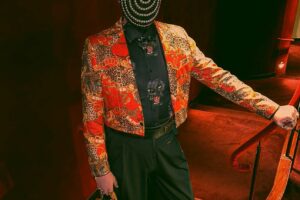
The crossover album: a hint that that an artist has either exhausted all the repertory at her command and owes her record label a new release or that her waning vocal resources really shouldn’t be taxed much further than an octave. I’m sure we all have our favorite party discs of beloved divas slumming Broadway, Tin Pan Alley, or worse.
Who among us can resist the lure of a beloved singer in offbeat repertoire? But then, who among us has been strong enough to draw the line after Eileen Farrell’s extraordinary contribution to the American songbook? Since then, we’ve had Leontyne with André Previn, Kiri with Nelson Riddle (and everything up the octave), Jessye with John Williams with and without the Boston Pops, and even Renée smelling like teen spirit. The bastard stepchild of all this slumming most certainly is Leonard Bernstein’s studio recording of his very own “West Side Story.” Oh, don’t worry, I’ve bought them all.
The music labels persist in these offerings because they sell and you didn’t have to be prescient to see this current duo forming in the mind of some eager record producer over at French Erato and Warner Classics. The teaming of the venerable French composer Michel Legrand with Natalie Dessay was surely a fait accompli. The result is the modestly titled “Entre elle et lui” (Between her and him).
Mme. Dessay only just formally retired from the opera stage with her final Manon last October in Paris, having decided to turn her formidable skills to presenting herself as a legitimate actress and chansonnier. M. Legrand is apparently game for another “greatest hits” album “diva style” since it’s been more than a decade since he recorded nearly the exact same program with Jessye Norman. (For those of you who missed that one the first time around, here’s a wonderful opportunity to rush right out and miss it again.)
Apparently this newest collaboration turned out joyously since they both gush over the other in the liner notes like long-lost lovers and the CD booklet pictures them repeatedly pawing each other so ferociously that Angela Gheorghiu and Roberto Alagna were forced to turn their heads away in modesty.
Mr. Legrand’s specialité is, or course, la ballade romantique and he’s written a lot of them. We have songs and duets here from Les Parapluies de Cherbourg, Peau d’Âne, Les Demoiselles de Rochefort and, yes, Yentl… to say nothing of classics standards like “What Are You Doing the Rest of Your Life?”, “Les Moulins de mon coeur,” and the theme from Summer of ‘42.
Ms. Dessay does manage to scale back her instrument to that of a diseuse fairly easily. But a voice with no bottom and a thin top really doesn’t belong in this fach: most female singers of popular music are mezzos for a reason. Her sung English is nearly flawless and mostly accent-free. Frankly, it’s almost as if she’s made a study of which vowels sound better with a little Gallic flavor. There’s also a generous helping of straight tone at the top which, while it’s nothing new from this singer and a valid stylistic choice, doesn’t enhance enjoyment levels.
“La Valse des lilas” finds her doing some low-grade scatting and jazz acrobatics which, although they couldn’t possibly be termed stratospherique, certainly did nothing for my nerves. The other problem is the very aggressive miking which even in a contemplative number like”Papa Can You Hear Me?” all but invites the response,”Far too well, I’m afraid.”
Mr. Legrand remains a nimble accompanist at 81 and he certainly knows how to play his own music. I find him refreshingly straightforward as his own interpreter where he could be lachrymose and indulgent in these songs as so many have been before. His one party trick consists of fingering a triplet up and down the chord in question with astonishing facility. He also duets rather piquantly with Ms. Dessay on two numbers to wholly charming effect even if pitches tend to stray. He’s backed up by Pierre Boussaguet on the double bass and Francoise Laizeau on drums and they prove an accomplished trio.
Outside of the big ballads the album features the kind of uptempo light jazz tracks that sound, not surprisingly, like the underscoring for the 60’s era art-house films they are. “Chanson des jumelles” from the movie Les Demoiselles de Rochefort finds our soprano in duet with Patricia Petibon, no less, achieving a horrifyingly accurate synchronicity. Happily, the accordionist wasn’t able to make the studio sessions that day.
Ms. Dessay’s husband, baritone Laurent Naouri, joins her for the famous duet from Les Parapluies de Cherbourg and I was very close to falling completely under its spell until about the five minute mark when the main theme modulated up, yet again, and it all became too much fromage.
I think “What are you doing the rest of your life?” remains the best track on the album. Even at nearly eight minutes in length it shows both singer and composer hitting an elegiac stride that, though broken at the halfway mark by an enormous improvisational interlude, displays a light touch. Similarly the baroque veneer of “Conseils de la fée des lilas” from Peau d’Âne finds Dessay in a familiarly classical mode and pleasantly underplaying.
She introduces a little mild growling into one of the saucier numbers and I suddenly had visions of our Natalie being presented at the Folies Bergère, swathed in feathers and sequins in the Sevent Circle of Cabaret Hell.
Frankly, I think the producers here lost a bet. Even if the majority of the music is relentlessly bourgeois there is evidently great joy in its making from the participants and it would have been a much fuller experience to see this as a filmed concert. Ms. Dessay excels at live performance and it would have enabled the viewer to share in this special collaboration. Safely though, as a souvenir of what was obviously a very happy project, for any fans of both these artists it’s an easy recommendation.
The booklet includes the aforementioned valentines and photos as well as all the lyrics of the songs but, oddly, no translations. So, English remains English and French remains French. Even though I generally break out in a rash at the sound of jazz, I’m happy to have made it through this album without even a single dose of antihistamine.



























Comments